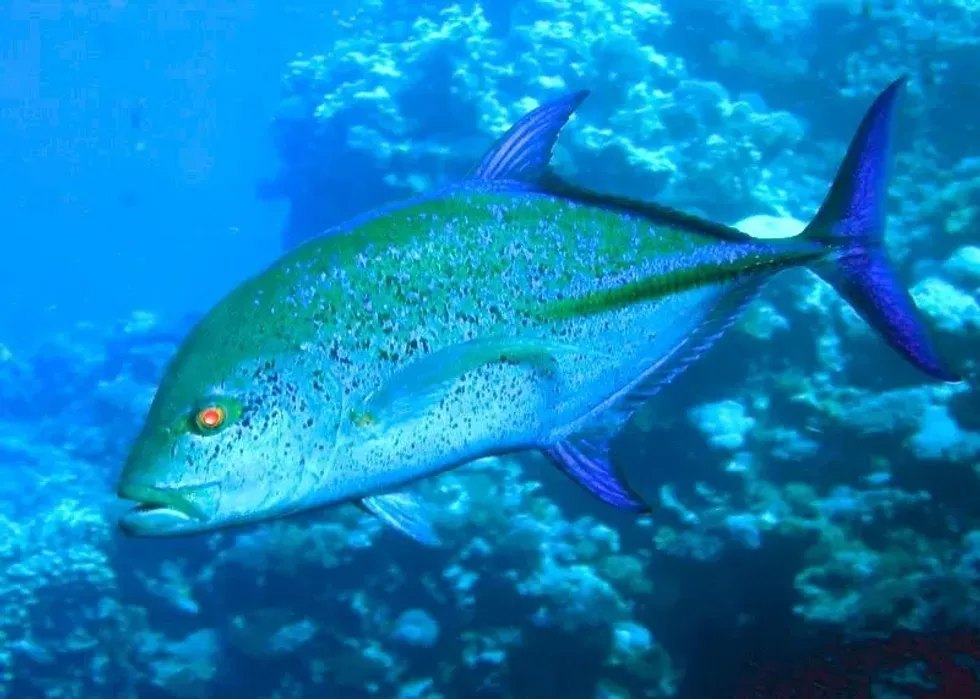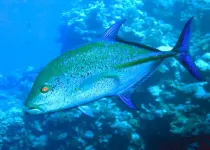There are a total of 150 species of jackfishes in the world, all of which possess compressed bodies and enlarged scales. The green jack fish belongs to the same family.
These fishes are primarily seen in the Pacific Ocean and are a popular choice for fisheries around the world, meaning for human consumption. Jack fishes are also seen in regions including Mexico, California, and other nearby regions. Their population is classified as Least Concern by the IUCN Red List.
These fishes have a silver appearance but a greenish tint to the scales, giving them their name. They are also popularly called horse jack fishes, and their scientific name is Caranx caballus. This species is carnivorous and feed on crustaceans, shrimp, and other smaller fishes to fulfil their dietary requirements.
Males and females reproduce through external fertilization. Parents are not that involved in raising their young. They travel together in schools and are seldom seen solitary.
For more relatable content, check out these fact files on pumpkinseed sunfish and codfish.
Green Jack Interesting Facts
What type of animal is a green jack?
The green jack (Caranx caballus) is a fish that belongs to the order Carangiformes.
What class of animal does a green jack belong to?
The green jack (Caranx caballus) is a fish that belongs to class Actinopterygii, family Carangidae, and genus Caranx.
How many green jacks are there in the world?
The exact population of green jacks (Caranx caballus) in the world is not evaluated. They are classified as a Least Concern species and are available widely. Their populations are considered to be increasing steadily.
Where does a green jack live?
A green jack lives in California, Mexico, Central to South America as well as in places like Peru. Adults prefer regions where they can find prey easily, and juveniles feed on relatively smaller fish species.
What is a green jack's habitat?
The green jack fish's habitat constitutes estuaries, bays, lagoons, and reefs. A green jack lives in the ocean, specifically the Pacific Ocean. They traverse through different levels of the water body and forage for food on the seafloor.
Who do green jacks live with?
Green jacks (Caranx caballus) travel together in schools and they are seldom seen alone. Juveniles once born learn to survive independently. They coexist with other marine life in the ocean.
How long does a green jack live?
The exact lifespan of a green jack is not evaluated. They are predominantly seen in California, Mexico, and certain parts of South America. As per records, the oldest fish in the sea is the Greenland shark and estimated to have lived for 400 years in a study conducted in 2016.
How do they reproduce?
The Caranx caballus (green jack) species reproduce via spawning. Females release eggs into the water body during the breeding season. Males fertilize the eggs outside their bodies.
After fertilization, parents are not involved in raising the young. The eggs float until they are ready to hatch and stay close to the regions they are placed in. They mostly inhabit the same waters.
What is their conservation status?
The Caranx caballus fish species is classified as a Least Concern species by the International Union For Conservation Of Nature (IUCN).
Green Jack Fun Facts
What do green jacks look like?
Green jacks are a fish species that look silver-gray in color with light stripes or a line and have a greenish tint to the scales, giving them their name. The green jack has two eyes placed laterally, which helps them see things easily.
Their head is rounded and they have a central line that is faint but present. Their head is the same color as their body, but the face does not have scales. Their fin is average in length and ensures ease in movements, and is V-shaped.
A green jack is never spotted alone and usually seen in groups called schools in oceans, estuaries, bays, lagoons, and reefs. They are mostly seen in Mexico, California, and other regions.

* Please note that this is an image of a school of jack fish. If you have an image of a green jack fish please let us know at hello@kidadl.com.
How cute are they?
The green jack is an exotic fish species and not necessarily cute in appearance. They are caught by humans for consumption purposes and not necessarily kept as pets. They can be seen in regions including the Pacific Ocean, Mexico, California, and Central and South America.
How do they communicate?
These green jack fishes, like other fishes, communicate via pheromones and chemical modes to communicate. These fishes interact with humans. They are a popular choice for fishermen.
How big is a green jack?
A geen jack is 15 in (38 cm) in length which is much bigger than the smallest fish in the world. The dwarf minnow is only 0.3 in (0.8 cm).
How fast can a green jack swim?
Green jack fish swim at a relatively good speed in the water. Sailfish are considered to be one of the fastest fishes in the water. These fishes can travel at speeds of 68 mph (109.4 kph).
How much does a green jack weigh?
A green jack weighs 6 lb (2.7 kg). These fishes are large enough to be bought for consumption purposes and are a popular choice for fishermen.
What are the male and female names of the species?
Male and females are not addressed differently. Males and females are similar in appearance as well but differ in reproductive functions.
What would you call a baby green jack?
A baby green jack can be called a fry or a juvenile. The fry develops by themselves and learns to live independently. They are not dependant on any person.
Fishes caught are usually adults since they largely travel in schools and are easy to trap. Juveniles lack the color and line patterns on their bodies and develop if overtime. They are short in length.
What do they eat?
A green jack is primarily a carnivore and consumes a carnivorous diet. They feed mostly on other marine animals, shrimp, smaller fishes like the minnow, and other crustaceans.
Juvenile fishes may feed on matter floating on the top layer of the water as part of their diet requirements. These fishes are easily attracted to bait set by fishermen. They are prompt predators and quick in their attacks.
Are they poisonous?
No, these fishes are neither harmful nor poisonous. These fishes are caught by fishermen worldwide and consumed by various humans. Although they are caught in great numbers, their populations have not been affected significantly.
Would they make a good pet?
No, this species is rarely adopted as pets. They are caught by fishermen after setting bait for consumption purposes. The bait needs to be strong and fishes caught are either sold immediately or sent to fisheries.
If you wish to see such species, you could visit water regions or an aquarium where they are specifically placed or visit regions like California and Mexico. These fishes travel together in schools. This helps them to avoid predator attacks.
Did you know...
The blue whale is a large whale species that is considered the biggest animal to live. Another large fish is the killer whale which is large in size and travels in groups.
Golden goldfishes are one of the most popular and attractive species of pet fish. They can survive in a wide variety of habitats and is commonly called a goldfish.
Schaefer's anglerfish is one fish species that has feet, unlike other fishes that don't. The feet are not exactly feet but fins which it can use as feet. Anglerfishes are known to eat dead fishes and other wild marine species as part of their diet.
There is a jack in the green folk custom that is celebrated on April 20 in association with Mayday in certain parts of the world. However, it has no connections to the green jack fish.
How did the green jack fish get its name?
They are mostly silver-gray in color but have a tinge of green to the ends of their scales, so they are named the green jack fish. They are also known by the name horse jack fishes, and their scientific name is Caranx caballus.
There are various other species of jack fishes that are present in water bodies. Some species of jack fishes are also called spiny mackerels owing to their sharp spines.
They are caught by fishermen around the world since they are easy to catch, and don't require much effort as compared to other fishes of equal length or bigger in size. Such fishes are caught and even sold to fisheries.
How do green jack fish compare with similar fish?
The green jack is a species native to Mexico, California, and certain American regions. Most jack fishes are caught by setting bait.
Their skin is considered inedible however they are consumed by a large population worldwide. The green jack is a fish that forms small groups and the crevalle jacks, a similar fish, are more spread out and is green to blue and almost blue-black in color and large fishes.
All species of jackfish have certain common traits and some distinct features which set them apart.
Some might be large in size while some might be short. This depends on their type, diet, and other external factors.
Here at Kidadl, we have carefully created lots of interesting family-friendly animal facts for everyone to discover! For more relatable content, check out these blobfish facts and swai fish facts for kids.
You can even occupy yourself at home by coloring in one of our free printable jack fish coloring pages.
* Please note that the main image is of a blue jack fish, not a green jack fish. If you have an image of a green jack fish, please let us know at hello@kidadl.com









